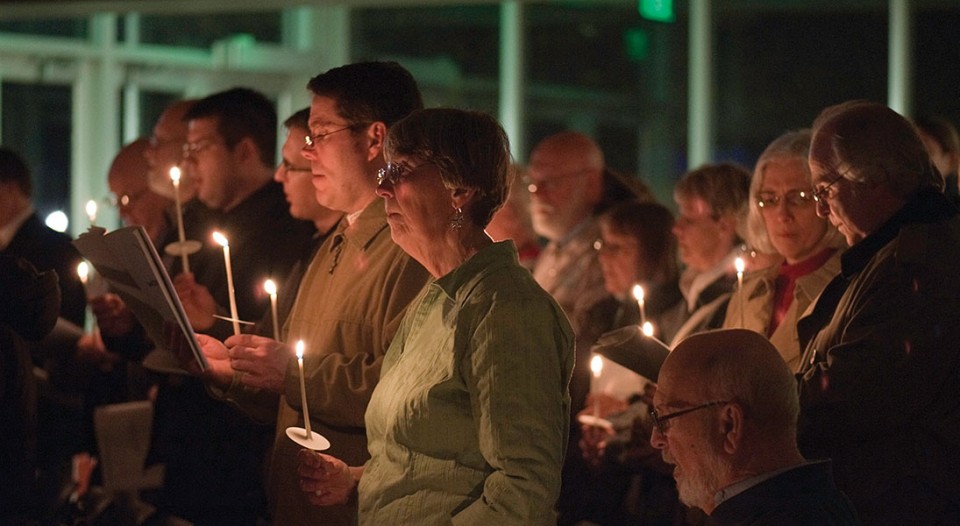For tens of thousands of years, communities have gathered to celebrate religious rituals. We can hear the ancient people saying, “Last year we danced all night long and then the rains came, and so this year we will dance once again.” Much religious ritual repeats what was done last year, or even last century, with people eating the same foods and singing the same songs.
This is true for Christian worship. We repeat the liturgy that the community knows and loves. At Easter everyone gathers—even those who haven’t come since last year—to sing beloved hymns and enjoy the flowers.
But Christian worship is also always changing. Christ’s life, death and resurrection get our brains going: Is there a better way to celebrate? At Easter we sing the ancient Jewish Psalm 118, but we do so in contemporary English to our tunes and with our youth playing their instruments.
In Martin Luther’s day, the men stood on one side of the nave, and the women and children stood on the other side. Those churches had no chairs or pews. (The worship scene in the 2003 movie Luther is totally inaccurate.) But two centuries ago, many Christians decided to sit together as families. As in the ancient church, the baptized gather for worship, but now we can sit women and men side-by-side.
Always both the old and the new: For ELCA members, all Christian worship is traditional and contemporary, never only one.
Rediscovering the Easter Vigil
In the past century many Christians around the world have asked whether churches were celebrating Easter in the best way possible. Perhaps a new way might include the very old way—the pattern used by Christians in the third and fourth centuries? Thus came about the rediscovery of the Three Days (Evangelical Lutheran Worship, page 258) and the restoration of the Easter Vigil (ELW, page 266).
In the vigil, this new-old-new way to celebrate Easter, we meet not in the sunlight but at night, still contained by the darkness of Good Friday. We gather, as have millennia of our species, around a great fire. We light candles. We tell our favorite stories of faith. We hear Genesis 1 because we know that we also have been created anew. We proclaim the Exodus story because we, too, have been brought through the water to dance on the safe side of the sea. In some assemblies, a Miriam dances for everyone, or the people join her in a conga line.
In Matthew 12:39-40, Jesus reminds his questioners about Jonah. So at the Easter Vigil we read the tale of Jonah. And Lutherans love the story in Daniel 3 of the three men in the fiery furnace—in some churches the whole assembly repeats together “the sound of the horn, pipe, lyre, trigon, harp, drum and entire musical ensemble” (Daniel 3:5).
Each story hints at Christ’s resurrection. The world is made new. The animals are protected in the ark. We are saved through water. A feast is served on a mountain. Christ walks with us in the fire. Some assemblies choose to proclaim the readings formally from the ambo (lectern or pulpit), as on Sunday. Other assemblies gather for this part of the service in the fellowship hall, with each reading presented by a family.
In the early church, Easter was the primary time of year to hold all baptisms. During Lent the candidates prepared for their baptism, and at the vigil the whole community celebrated what Paul wrote in Romans 6, that in baptism we are raised to life with Christ. Nowadays at the vigil, if there are no scheduled baptisms, we still all remember our baptism, as water from the font is sprinkled on the whole assembly.
If you attend both the Easter Vigil and worship on Easter Day, you celebrate Christ’s resurrection in two different ways.
On the Eve of Easter you light a fire and carry candles, process, hear stories (and maybe dance), celebrate baptism and share the first eucharist of Easter. On Sunday morning you wear pastel colors, enjoy the springtime flowers, listen to choir music, and share the bread and wine of Easter. Perhaps at the vigil you share a freshly baked loaf of bread, and on Easter Day you use rounds of Mediterranean pita. At the vigil you sing the eighth-century hymn “Come, You Faithful, Raise the Strain” (ELW, 363), and in the morning the 18th-century hymn “Jesus Christ Is Risen Today” (ELW, 365).
In Accidental Saints: Finding God in All the Wrong People (Convergent Books, 2015), ELCA pastor Nadia Bolz-Weber writes about her 21st-century assembly of believers in extremely colloquial English. But she holds her book together with quotations from the ELW Vigil of Easter. For Bolz-Weber and many other Lutherans, one new way to celebrate Easter is helped by the old way. Perhaps most ELCA members will come to agree with her. M





